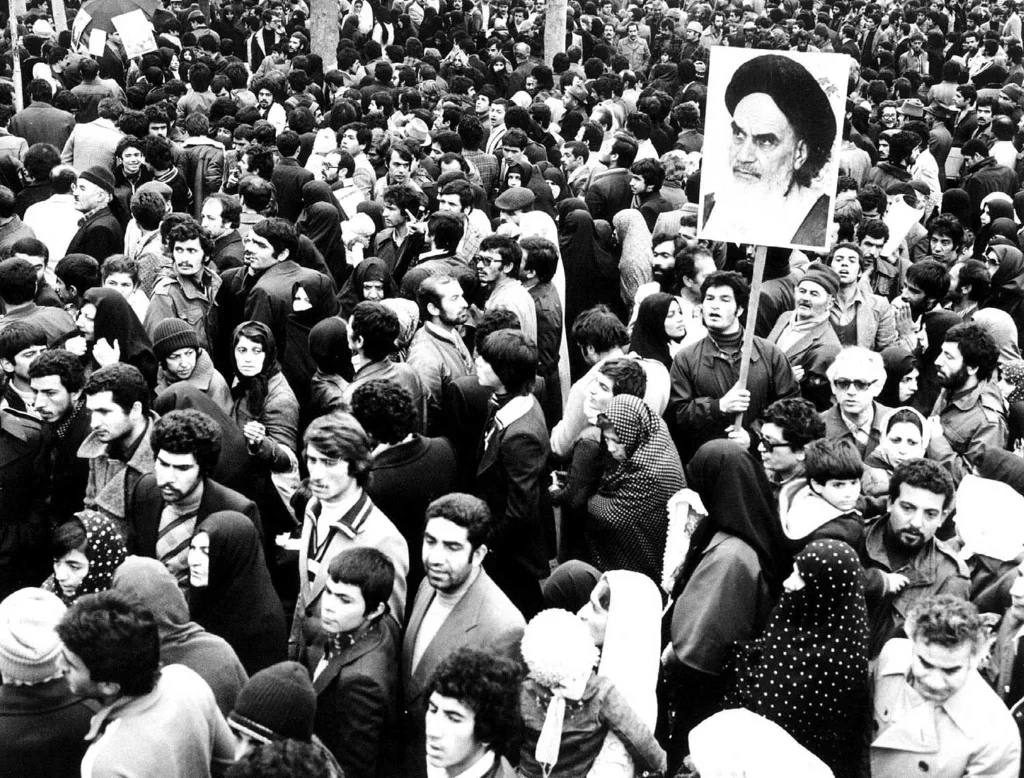The Iranian Revolution stands as a pivotal event in the late 20th century, altering the course of not only Iran’s history but the geopolitical landscape of the Middle East. Sparked by widespread dissatisfaction with the Shah’s regime, the Revolution drew together diverse factions including liberals, clerics, and leftists, ultimately coalescing under the leadership of Ruhollah Khomeini. The causes of the Iranian Revolution are complex, involving grievances over political repression, economic disparity, and the perceived excesses of the Shah, all intertwined with the geopolitics of Iran oil politics. American involvement in Iran, particularly the 1953 coup that reinstated the Shah, also played a crucial role in igniting widespread resentment. As we delve deeper into the history of the Iranian Revolution, it becomes clear that the winds of change were set in motion by a confluence of accidental events that transformed a nation and reshaped its identity.
The 1979 Islamic Revolution in Iran, also referred to as the Iranian Islamic Revolution, was a defining moment that dismantled the Pahlavi monarchy and established a fundamentalist regime. An amalgamation of various socio-political frustrations fueled the uprising, where discontent across social strata forced the Shah to flee the country. Key figures such as Khomeini emerged as pivotal leaders during this unpredicted upheaval, impacting not only Iran’s future but also reverberating through international relations concerning oil politics and Western intervention. Understanding the myriad causes behind this momentous event elucidates the multifaceted reasons why revolutions can erupt seemingly from nowhere, often set off by small sparks in a wider climate of unrest. Historical reflections on the Iranian uprising illuminate the chaotic nature of revolutionary change, where the fragmentation of society can unexpectedly coalesce into a powerful movement.
Understanding the Iranian Revolution: A Historical Context
The Iranian Revolution, which culminated in 1979, was a dramatic turning point in the history of Iran and the Middle East, fundamentally altering political dynamics for decades to come. Rooted in a complex interplay of historical, social, and political factors, the revolution arose against the backdrop of widespread disenchantment with the Shah’s regime. Various groups, ranging from secular liberals to religious clerics, harbored grievances ranging from economic inequality to political repression, creating a fertile ground for revolutionary fervor. This multifaceted unrest ultimately saw the rise of Ayatollah Khomeini, who harnessed the discontent and united disparate factions under a common cause against the monarchy.
The overthrow of the Shah, who was once touted as a bulwark of stability in the region and a close ally of the United States, reflected a broader discontent with Western influence in Iranian affairs. With the aid of oil-rich revenues, the Shah maintained a firm grip on power, leading to significant military buildup and lavish public displays that sat uneasily alongside the growing poverty and disillusionment among ordinary Iranians. As various opposition groups began to coalesce, the revolution gained momentum, leading to a historical upheaval that transformed Iran from a pro-Western monarchy into an Islamic Republic.
To fully comprehend the complexities of the Iranian Revolution, it is critical to examine the causes that motivated the masses to rise against the Shah’s government. Among the major catalysts was widespread frustration over systemic corruption, economic mismanagement, and the regime’s authoritarian methods. Many Iranians felt increasingly alienated from the ruling class, as the wealth generated from oil revenues failed to trickle down effectively. This created a sense of relative deprivation, where those who lived comfortably began to feel guilty amidst a vast majority struggling for basic needs. With the added instability caused by changing global oil politics, the revolution was both a response to immediate social injustices and a long-simmering reaction to the undemocratic practices of the Shah’s regime.
The Role of Khomeini and the Shah in the Revolution
A pivotal figure in the Iranian Revolution, Ayatollah Ruhollah Khomeini emerged from relative obscurity as the embodiment of resistance against the Shah’s regime. Initially exiled due to his outspoken criticism, Khomeini’s absence only amplified his symbolic power, catalyzing public sentiment against the monarchy. His return to Iran marked a significant turning point, transforming the unrest into a coordinated movement that could effectively challenge the state. Khomeini’s religious authority resonated deeply with a populace increasingly disillusioned by years of corruption and intimidation under the Shah’s rule. He deftly positioned himself as the defender of the Iranian people’s rights, intertwining Islam with anti-imperialist rhetoric that appealed to a wide spectrum of society, from shantytown dwellers to university students.
On the opposite end was Mohammad Reza Pahlavi, the Shah, whose reign became synonymous with excess and oppression. His early relationship with the United States, marked by a CIA-backed coup that reinstated him after the ousting of Prime Minister Mossadegh, further alienated many Iranians who viewed Western influence as a catalyst for their struggles. Despite amassing vast wealth and power, the Shah’s inability to adapt his political methods or address the growing dissent underscored the disconnect between him and his people. His rigid approach to opposition—combining censorship with violent repression—ultimately fueled the revolutionary fervor that dismantled his regime.
The dynamics of Khomeini’s leadership versus the Shah’s authoritarian governance shape much of the narrative surrounding the Iranian Revolution. Khomeini capitalized on the Shah’s missteps, including the disastrous response to protests that saw violent crackdowns on demonstrators, which only intensified the public’s outrage and solidified Khomeini’s status as a national leader. Khomeini’s ability to unite various factions against a common enemy—this included secularists, Islamists, and leftists—was crucial in fostering a collective identity among revolutionaries that cut across social divides.
By the end of the revolution, the power dynamics had shifted dramatically, leading to the establishment of a theocratic regime in which Khomeini held the reins of authority. This transformation marked a distinct shift not only in Iranian governance but also within regional geopolitical relations, as the new Islamic Republic adopted a confrontational stance against the West, particularly the United States. Khomeini’s vision of a government guided by Islamic principles defied both Western expectations and historical trajectories, resulting in a complex legacy that continues to influence Iran and its relationship with the world today.
The Economic Factors Influencing the Iranian Revolution
Economics played a crucial role in the lead-up to the Iranian Revolution, intertwining with social grievances to create a volatile atmosphere ripe for revolt. The wealth generated from Iran’s significant oil reserves had, for years, been a double-edged sword: while it enriched the Shah’s regime and empowered military expansion, it also exacerbated economic inequities among the populace. Many Iranians found it increasingly frustrating that, despite the country’s oil wealth, they remained in poverty, especially as food prices soared and basic goods became scarce. Discontent with ongoing economic struggles laid the groundwork for unrest, as Iranians demanded not only political reform but more equitable economic policies to ensure fair distribution of resources.
With the international oil politics also affecting Iran’s economy, fluctuations in price and demand further complicated domestic affairs. Prior to the revolution, the Iranian economy boomed as oil prices surged in the early seventies. However, the subsequent downturn, coupled with mismanagement and corruption, created a growing crisis. The Shah’s reliance on foreign alliances, particularly with Western powers, made many Iranians feel that their economic well-being was subordinated to international interests. The disconnect between the ruling elite and the average citizen fostered a perception that the monarchy was out of touch, fueling calls for revolution as disillusioned citizens sought a more just and responsive governance that aligned with their economic aspirations.
As the protests against the Shah grew in intensity, the economic backdrop of inflation, unemployment, and rising prices of essential goods and services became intertwined with the larger calls for civil rights and political reform. The rapid urbanization experienced by Iran in the preceding decades had led to a mass migration of people from rural areas seeking better opportunities in the cities. However, the urban infrastructure was unable to cope with this influx, leading to overcrowding and heightened poverty levels. Economic disenfranchisement intensified the desire for change, as many Iranians yearned for a government that could address their needs rather than one mainly focused on militarizing the nation or lavish public displays.
Despite the Shah’s efforts to modernize Iran’s economy through reforms and industrialization, these initiatives often perceived as top-down and disconnected from the populace, ultimately failed to quell discontent. The revolution ultimately brought to light the citizens’ desire not just for a change in regime but for a complete overhaul of an economic system that many viewed as corrupt and elitist. Khomeini adeptly tapped into this sentiment, promising a government that would prioritize the marginalized and ensure justice, propelling the revolution forward.
American Involvement in the Iranian Revolution
American involvement in Iran significantly influenced the course of the Iranian Revolution, ultimately shaping its trajectory and outcomes. The United States had long viewed the Pahlavi regime as a strategic ally in the Middle East, partly due to Iran’s vast oil reserves and its geographical position. The CIA’s orchestration of the 1953 coup that reinstated the Shah after his removal of Prime Minister Mohammad Mossadegh created deep-seated resentment among many Iranians, who increasingly viewed the U.S. as a puppet-master in their national affairs. As the revolution unfolded, the perception of American support for the Shah only intensified the public’s resolve against both the monarchy and foreign interference.
Carter’s administration, which prided itself on promoting human rights, found itself in an uncomfortable position as the revolutionary fervor grew. Initially, Jimmy Carter supported the Shah, urging him to implement reforms while hesitating to apply firm pressure regarding human rights abuses amid escalating protests. This equivocation allowed discontent to fester and led many Iranians to feel betrayed, as they viewed American intervention—and subsequent inaction—in maintaining the Shah’s authority as complicity in the regime’s repression. Such perceptions fueled anti-American sentiment that continues to impact Iran-U.S. relations today.
As the revolution gained momentum, the failure of American intelligence and diplomatic channels to accurately assess the situation in Iran compounded tensions. Carter’s administration was caught off guard by the rapid escalation of unrest, revealing a glaring lack of understanding of the Iranian political landscape. As reports of violence against protesters emerged, Iranians perceived the U.S. as not only disingenuous in its human rights rhetoric but also directly complicit in the ongoing oppression by maintaining military ties and arms trade.
After the Shah’s departure in January 1979, the rapidity of events put U.S. officials in a precarious position, culminating in the seizure of the U.S. Embassy in Tehran later that year. This event solidified the revolution’s anti-American core, transforming the U.S. into an adversarial figure within the new Islamic Republic. The U.S.’s historical involvement ultimately became a symbol of a larger struggle against imperialism and foreign dominance, as revolutionary leaders like Khomeini effectively leveraged these sentiments to consolidate power and navigate a newly independent Iran.
The Unexpected Nature of the Iranian Revolution
The Iranian Revolution often takes historians and political analysts by surprise due to its unexpected and rapid nature. When examining the dynamics at play leading up to 1979, many observers were not prepared for how swiftly the regime would collapse, especially given the Shah’s seemingly firm grip on power. At the peak of his authority, the Shah was backed by Western military support and vast financial resources derived from oil. However, a series of miscalculations—from his underestimation of popular unrest to misjudging the resilience of opposition movements—contributed to an avalanche of dissent that ultimately engulfed his regime. The combination of social unrest, factional grievances, and external pressures culminated in a revolutionary wave that took both the government and revolutionaries themselves by surprise.
Historians often reflect on the revolutionary events as a classic example of the ‘butterfly effect’ in which small, seemingly insignificant occurrences can lead to monumental changes. This notion is underscored by events such as the incendiary editorial in the newspaper Etalaat, which provoked massive demonstrations against the government, marking a turning point in public sentiment. Such events highlight how seemingly minor sparks can ignite underlying societal tensions, and how the amalgamation of diverse political grievances rapidly coalesces into a larger revolutionary movement. Acknowledging this complexity illuminates the unpredictable nature of revolutions and the inherent volatililty of societal discontent, affirming that the course of history can often defy expectations.
One crucial aspect that contributed to the unexpected nature of the Iranian Revolution is the phenomenon of ‘preference falsification.’ Until the public protests took flight, many Iranian citizens felt compelled to hide their true sentiments due to the repressive environment created by the Shah’s regime. Years of surveillance by SAVAK, the secret police, cultivated an atmosphere of fear, leading people to publicly conform to state narratives while privately harboring substantial dissent. As the protests began, individuals found the opportunity to vocalize their frustrations and grievances that had long been suppressed. This transition from concealed sentiments to open rebellion enveloped society in a swift, collective realization of shared discontent, catching those in power off guard and making the scale of the revolution seem sudden and overwhelming.
Frequently Asked Questions
What are the main causes of the Iranian Revolution?
The main causes of the Iranian Revolution include widespread dissatisfaction with the Shah’s authoritarian regime, economic hardships, increasing social inequality, and rising religious opposition led by figures like Ruhollah Khomeini. Corruption, repression by the Shah’s secret police (SAVAK), and a reaction to foreign influence, particularly U.S. involvement in Iranian affairs, also fueled the revolutionary spirit.
How did Khomeini’s views shape the Iranian Revolution?
Ruhollah Khomeini’s views greatly shaped the Iranian Revolution by providing a unifying ideology against the Shah’s regime. His criticism of the monarchy and vision for an Islamic government resonated with a diverse coalition of Iranians, including secular and religious groups, ultimately leading to a revolutionary movement that sought to establish a new political order based on Islamic principles.
What role did American involvement in Iran play in the Iranian Revolution?
American involvement in Iran played a critical role in the lead-up to the Iranian Revolution, particularly through support for the Shah’s regime, which was viewed as oppressive and corrupt. The 1953 CIA-backed coup to reinstate the Shah fostered deep resentment among Iranians, contributing to the widespread perception of the U.S. as complicit in the Shah’s tyranny, which galvanized opposition movements.
What impact did the Iranian Revolution have on Iran’s oil politics?
The Iranian Revolution significantly altered Iran’s oil politics by shifting control from the Shah’s pro-Western policies to a government led by Khomeini and his followers. Post-revolution, Iran nationalized its oil industry, reducing foreign influence and altering global oil dynamics, which caused geopolitical tensions, particularly with the U.S. and neighboring countries.
In what ways did the history of the Iranian Revolution influence modern Iran?
The history of the Iranian Revolution has profoundly influenced modern Iran by establishing a theocratic regime that prioritized Islamic law over secular governance. This transformation has had lasting effects on Iran’s domestic and foreign policies, contributing to a focus on anti-Western sentiment, suppression of dissent, and the establishment of a unique political system blending Islamic authority with state governance.
| Key Points |
|---|
| The Iranian Revolution was precipitated by a series of accidents, oversights, and socio-political tensions rather than a single event. |
| The U.S. had previously supported Mohammad Reza Pahlavi, the Shah of Iran, who ruled with a tight grip, leading to widespread dissatisfaction among various Iranian factions. |
| Ruhollah Khomeini emerged as a prominent opposition figure, utilizing his exile to galvanize support against the Shah. |
| The publication of a slanderous editorial against Khomeini triggered mass protests, highlighting the unpredictable nature of revolutionary dynamics. |
| The revolution saw the participation of diverse groups, indicating a unified front despite differing ideologies and agendas. |
| Khomeini’s leadership, initially vague and unifying, evolved towards strict theocratic control post-revolution. |
| The aftermath of the revolution led to widespread human rights violations under Khomeini’s regime, contrasting sharply with prior expectations of freedom. |
| The revolution’s unpredictability underscores the importance of acknowledging both individual agency and larger social forces in historical events. |
Summary
The Iranian Revolution was a pivotal event in history that almost didn’t occur, driven by a complex interplay of political oversight, cultural tensions, and unforeseen circumstances. This revolution marked a significant shift from a pro-Western monarchy to an Islamic republic under the leadership of Ruhollah Khomeini, showcasing how a combination of social forces and individual actions can dramatically reshape a nation’s trajectory. The dynamic nature of the revolution highlighted both the fragility and the power of collective action, leading to a regime steeped in authoritarianism that drastically altered the course of Iran and had lasting repercussions for the region.



